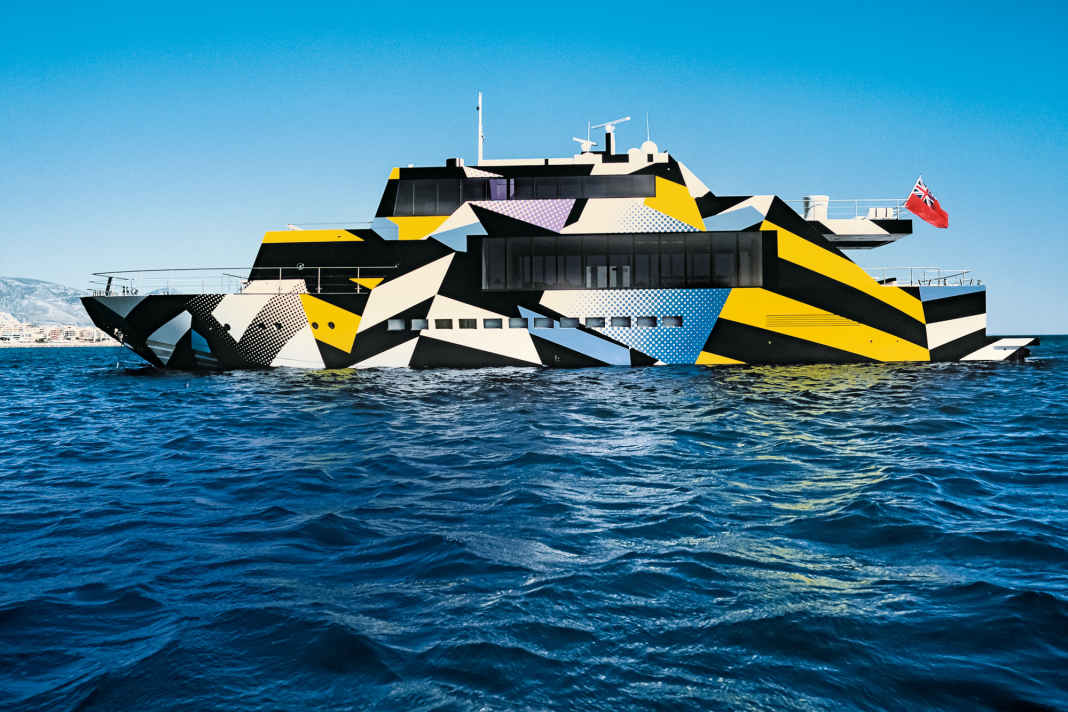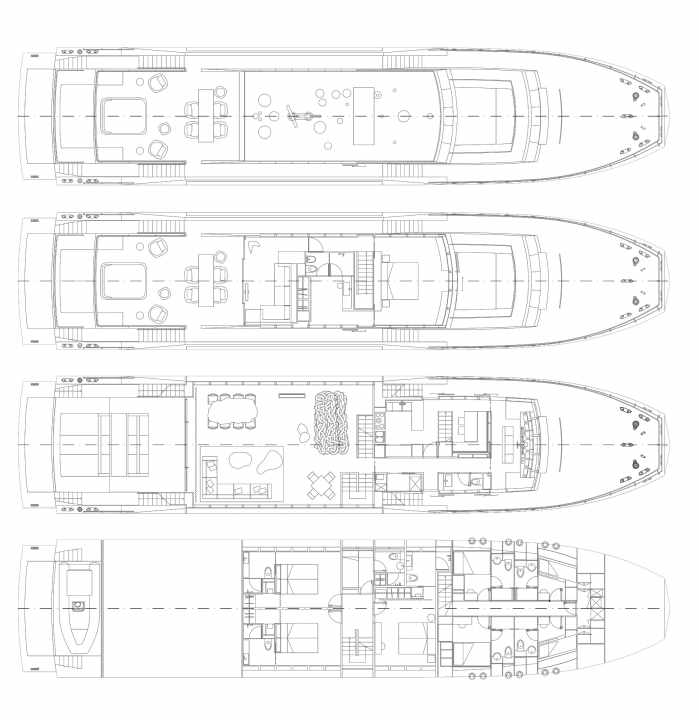





"When Dakis decided to build a new boat, I recommended a Razzle-Dazzle concept for the exterior." This is how US object artist Jeff Koons explains the start of what is probably the most visually spectacular appearance of a yacht to date. Dakis, that is Dakis Joannou, a Cypriot architect and building contractor based in Athens, whom no one would know internationally if he were not one of the most important collectors of contemporary art.
It goes without saying that his house in Athens is full of paintings, sculptures and installations. Joannou uses it partly as a permanent exhibition space, like a museum, and partly as a gallery with changing presentations. This also includes hoarding product designs from the sixties and seventies. He loves furniture by designers such as Mollino and Sottsass.
Wedding with ex-porn actress Cicciolina
And the artists? He is particularly fond of Jeff Koons. Joannou currently owns the most extensive collection of works by the man who can claim to be the best-paid artist in the world. Jeff Koons' "Balloon Dog (Orange)" realised an impressive 58.4 million US dollars at a Christie's auction in 2013.
The tightrope walker between kitsch and art always knows how to attract the attention of the media with or without his oversized sculptures. He was able to dispense with any artistic endeavours when he married Ilona Staller in 1991. The former porn actress with the stage name Cicciolina - "Schnuckelchen" - was elected to the Italian parliament in Rome in 1987 by green believers. This political commitment took up so much of her time that she shot her last revealing film in 1989, only to marry the American object artist two years later.
Camouflage pattern on the hull, but colourful
It goes without saying that Koons turned the wedding into a media event. And he wouldn't have been Koons if he hadn't exploited the marital intimacies down to the last detail with sculptures and large-format paintings. Some saw Adam and Eve at work here, others an attempt to make the porn industry socially acceptable. As a shrewd marketing specialist in his own right, Koons can be considered unrivalled to date.
But what does razzle-dazzle mean? The term itself is as confusing as it looks when written. "I explained to Dakis," says Koons, "that razzle-dazzle was a technique used to camouflage ships during the First and Second World Wars." And he was right. The idea was to confuse the enemy at sea. The paintwork with large bevelled lines in light and dark contrasts on the hull and superstructure was intended to make it difficult to identify the warships and also some merchant ships. Particularly at greater distances and in poor visibility, the height, length and direction of travel are difficult to recognise due to the imitation fore and aft sterns and bow waves. Razzle-Dazzle fits in with this from the lettering alone and can also be translated as "deceptive manoeuvre". However, terms such as "tumult" and "showmanship" are also part of the meaning.
Which brings us back to Koons after a diversion via the navy. Another correct and far friendlier translation would be "brilliance", which would then plunge us into the world of the true, the beautiful and the good, where, according to common perception, art should also be at home.
"The next day, I told Ivana Porfiri about my idea and she immediately agreed. I got the job." The designer was the third in the team to realise a project that was as unusual as it was wondrous. The Italian had already made a name for herself with yacht designs that were obviously out of the usual yacht design mould. These included the 41 metre long Baglietto "Blue Ice" from 1999, the 42 metre long "Nina J", also built by Baglietto, and the 31 metre long "PAB" from the halls of Cantieri Navali Lavagna, built in 2003. Together, Koons and Porfiri brought collector Joannou's thoughts to life: "Magic means that things happen almost effortlessly. It is magical when a contradictory coincidence turns into a great concept, when ideas take on a strong form. And: "Magic is simply the blend of two extraordinary talents."
Reduction and clarity define the interior design
Joannou's previous yacht was built by the same shipyard that supplied "Guilty", Cantieri Navali Rizzardi. That was back in 1999, and the collector's 29-metre-long floating gallery at the time, an extended Technema, was called "Protect me from what I want" after a light installation by Jenny Holzer in New York's Times Square. Ivana Porfiri also designed its interior, and he also furnished this "Guilty" predecessor with works from his collection, in an interior design framework that left little to be desired in terms of reduction and clarity. The basic material for the ceilings and walls was beech wood, which at least radiated a little warmth. The only thing that remained of this interior model in "Guilty" was the structural reduction of the rooms to clear geometries. For "Guilty", Ivana Porfiri drew on the experience she had gained with "Nina J": surfaces in white, glacier white to be precise, which, together with large glazing, reflect all the changes in natural light during the day.
And instead of beech wood, square metres of synthetic Corian were not used everywhere, but frequently, in order to create the smoothest possible surfaces. Corian, a DuPont brand name, refers to an acrylic stone, a mineral-organic composite material that can be processed without joints, for example as a replacement for floorboards on the "Guilty" upper deck, which is reserved exclusively for the owner, with a bedroom, panoramic view and private terrace over the bridge ahead, small owner's saloon with corner sofa and large open space aft.
"Guilty" was developed from the inside out
Critics of such minimalist interiors like to dismiss them with the patronising adjective "aseptic", whereas these surfaces, at least in this case, only serve to make the works of art look good. This was also the reason for developing the project from the inside out, i.e. not adapting the interiors to the external functional form of a watercraft but, conversely, making the internal function of serving the collection the benchmark. The character of a yacht was nevertheless to be retained. This also applied to Koons' treatment of the exterior surfaces, despite all the borrowings and quotations.
"I wanted to preserve the profiles and shapes with their modernity, while at the same time seeking a connection to the past. The sides of the hull have a dialogue with the pyramids, the image of an oasis with a mirage. I also imagined how the boat would look in the water. In calm seas, the effect of the patterns would even double and make the whole impression even more abstract." Nevertheless: "I wanted to keep the boat a yacht."
Stem shortened by two metres so that "Guilty" fits into the berth
And "Guilty" also retains this character inside, despite its function as a collector's "treasure chest". As usual with a format like this, guests sleep on the lower deck in three cabins, which are distinguished by their colour schemes. A fourth cabin on the port side can be useful as a pilot's berth. The crew sleeps conventionally in the bow. The main deck with saloon and dining area accommodates not only the galley, but also the bridge, the captain's black interior workplace.
A clear, yet bizarre perspective awaits him every day: "Guilty" is easily recognisable not only by her colour scheme, but also by her bow shape; Joannou had the stem cut off. The reason is simple: the collector's home berth measures two metres less than the shipyard's GRP hull. These two metres had to be shortened: at the bow. What would be a serious sin in terms of external appearance on other yachts fits in with the razzle-dazzle concept on the "Guilty": surprise. Perhaps deception? But a closer look also confirms that the stem tip is indeed missing, although this has not affected the seaworthiness so far. Doing without the useless is also one of the tricks of the trade.
Technical data "Guilty"
- Length over everything:35,30 m
- Width: 7,40 m
- Depth: 1,50 m
- Displacement (empty): 165 t
- Displacement (100 %): 198 t
- Material: GRP
- Motor: 2 x MTU 16V 4000 M90
- Engine power: 2 x 2720 kW
- Speed (max.):29 kn
- Speed (travelling): 27 kn
- Fuel: 26 500 l
- Water: 3200 l
- Construction: Arrabito Naval Arch.
- Exterior design: Ivana Porfiri
- Camouflage project:Jeff Koons
- Camouflage eng: gP service
- Interior design: Ivana Porfiri
- Classification: + RINA
- Shipyard: Cantieri Navali Rizzardi/Sabaudia, 2008

Appearance in music video "No Reply" by Ufo 361
Hiphopper Ufo 361 shot the video for his song "No Reply" on the "Guilty:

